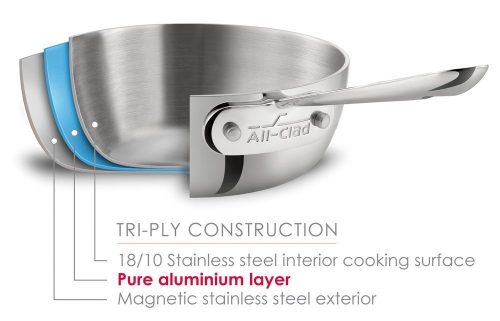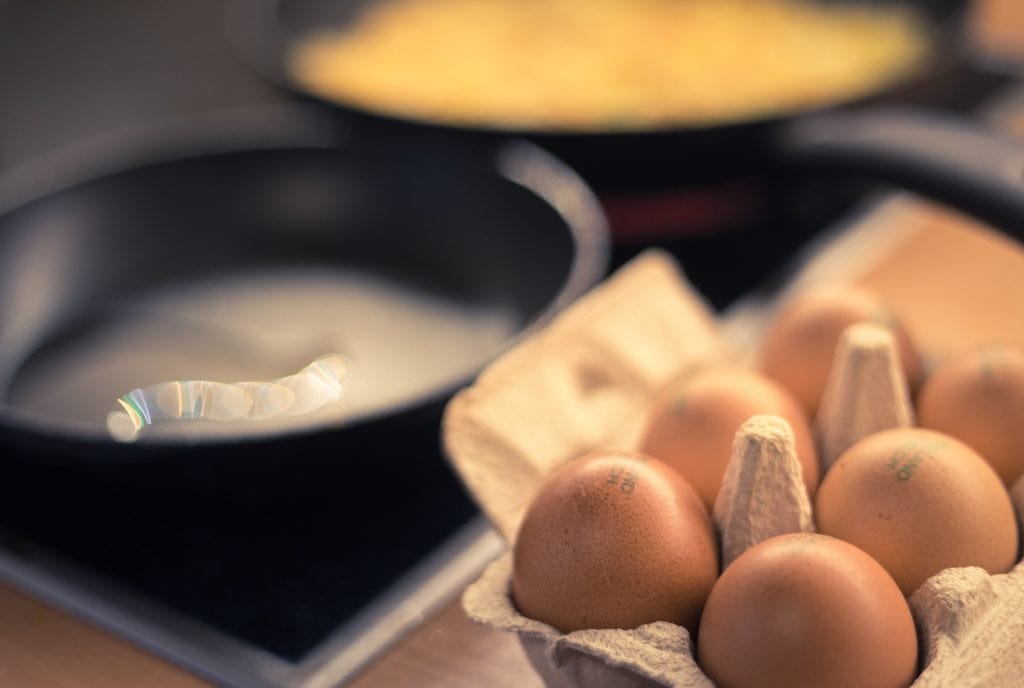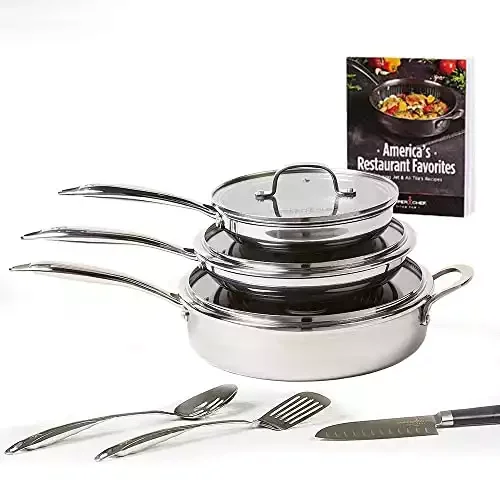Copper Chef’s Titan set is a good buy if you need a few essential nonstick cookware pieces. The design looks great and the pans have a nice heavy feel to them.
In this article you’ll find the summation of more than a dozen hours of product research, including:
- Extensive analysis of owner feedback
- Comments from the manufacturer
- A review of patent filings
What we like
- Sleek and attractive design.
- Practical sizing and solid weight pan.
- Compatible for induction stoves.
What We don’t
- Ads sensationalize the pan’s true performance.
- Closely follow care instructions or the nonstick will fade.
- Metal utensils included in the bundle are not compatible with the pan.
In This Article
Construction
The Copper Chef Titan line is both nonstick and clad, a combination that isn’t unheard of but certainly not the most common either. I’ll break down what that means, and why it should matter in your kitchen.
Most nonstick pans are built atop a pressed or cast aluminum base, which will heat very quickly but doesn’t do a great job of retaining that heat. If the temperature of your burner fluctuates or has hot spots, a standard aluminum pan is likely to cook the food unevenly.
“Cladding” is a process of layering different metals in order to combine the best properties of each one in a single piece of cookware.
These Copper Chef pans use cladding in a tri-ply design, meaning that there are three layers of metal bonded together to create the base of the pan. A layer of aluminum sandwiched between two layers of stainless steel creates a responsive dish that cooks evenly and retains heat effectively.

This is essentially the same base construction made famous by All-Clad’s D3 line, which was unrivaled until their patents expired in the early 2000s.
A critical design difference between the two is that the Copper Chef Titan adds non-stick convenience atop the clad metal base.
Nonstick
Copper Chef uses one of the slickest materials in the world to create the nonstick cooksurface atop the Titan’s clad metal base. It’s called PTFE.
You may be familiar with PTFE by the name “Teflon,” which is a well-known brand name that has been used in cookware since 1954. The full chemical name is Polytetrafluoroethylene, but for this article I’ll just use the PTFE acronym to stop myself from going down a nerdy cookware rabbit hole.
PTFE provides amazing food release, which is convenient when you’re preparing delicate foods like eggs or fish that might break apart after sticking. It also takes a lot of work out of post-meal cleaning, since most food doesn’t adhere to the cook surface in the first place. And any that does usually brushes off gently.
Durability
There is one common drawback with non-stick cookware that you should be aware of before purchasing this (or any other) cookware set. Nonstick cookware is not exceptionally durable.
In my experience, most products only last about 2 years when treated right. Even the top-performers last around 5 years with proper care and regular use.
For example, my family has been using an All-Clad HA1pan for just over 5 years and it probably only has a few weeks left in the tank. Nothing lasts forever. Not even a pan that is about 50% more expensive than the Copper Chef Titan.
At the time of our Copper Chef Titan pan review, the product has only been on the market for a few months. It debuted in 2020 at the Inspired Home Show in Chicago. Not enough time has passed for us to see trends on how long this pan should last in the hands of an owner who cares for it properly.
My best advice is to familiarize yourself with the 11 ways you’re probably going to ruin your nonstick pan, and learn how to avoid them. Beyond that, expect to be replacing your pan in a few years if you treat it with care.
If your main priority is durability, you might consider another cookware material like cast iron, carbon steel or uncoated stainless steel pans. These materials are often more expensive, harder to use and maintain for the casual cook, but they’re also the sort of pieces that get passed down from one generation to the next.
Design
The stainless steel exterior and handles on the Copper Chef Titan look refined, professional and compelling. Compared with a lot of nonstick cookware products, these look great!
The overall look and feel of the line is reminiscent of uncoated cladware that you’ll find in most professional kitchens. Of course, the interior cooksurface is also laden with a modern diamond-like pattern that is more akin to other traditional home nonstick products.
While the aesthetics of the Titan are excellent, there are a few practical elements of the line that I wish were done differently.
According to several owners, the rims on the lid have a tendency to trap oil, liquid or pieces of ingredients. These areas of the lid can be hard to clean, which is essential if you want to prevent bacteria growth.
This might not be an issue for you, if you’re not using the lid regularly or don’t mind cleaning with a bristled brush that can get in the small crevices of the lid’s rim.
If cleaning the lid does become an issue, check if any other lids in your collection will fit. There are also a variety of white label tempered glass cookware lids available on Amazon starting around $15 if you simply want something different.
Diamond Coating
One of the benefits raised by Copper Chef about the Titan line relates to the heating capacity of diamonds that are infused into the pan’s non stick coating.
It’s very common these days for cookware makers to “infuse” copper, titanium or even diamonds into the non stick coating.
Be assured that they aren’t using gem grade materials. Most patent filings for diamond-infused cookware coatings outline a manufacturing process that includes industrial grade, lab grown diamond dust or a diamond-like material such as quartz.
While diamonds may provide an incremental benefit to the rate that heat travels across the surface of the PTFE-nonstick, diamond-free pans also tend to heat quickly.
The heating characteristic of the pan is driven more specifically by the base materials. Aluminum helps these Copper Chef pans heat quickly, while stainless steel ensures it retains heat.
The non stick coating does create some limitations on what temperatures this pan is appropriate to cook with. This is a low-to-medium heat pan. You should never cook with it on a high temperature.
While PTFE like what is used in the nonstick coating on the Copper Chef Titan pan is considered food safe and “inert” by experts, it will also break down at high temperatures above 500 F at which point it can cause short-term flu-like symptoms in humans.
Sizes
The Copper Chef Titan is sold as a 5-piece set which includes a saute pan with a tempered glass lid, a fry pan, steamer tray, and a recipe book authored by Jet Tila. There are two bundle options which allow you to choose between a 9.5” or 11” Saute Pan.
The 11” Saute Pan is well-sized if you have many mouths to feed, and a wide burner. Many American burners are 6” in diameter, which may be too small for this pan. Cooking with a large pan on a small burner may cause uneven heating, especially when cooking dry food.
Price
This is mid-range nonstick cookware.
You don’t have to look far to find other options that are half the price of the Copper Chef Titan. It’s also not difficult to find “luxury” nonstick products that cost double.
I will caution you that more price doesn’t always equate to a “better product” with cookware, and this especially holds true for nonstick pans. There is always a tradeoff though.
With the Titan pan, Copper Chef does a good job of minimizing those tradeoffs. It looks good, performs effectively and is available in practical shapes and sizes.
Product pricing is set-up to incentivize purchasers to choose the “package deal” as opposed to an individual 9.5-inch pan. As evidence, the 10-piece set is only twice as expensive as a single piece.
The full cookware set comes with the well-sized pans, matching lids, a chef’s knife, cookbook and metal utensils. I must emphasize that you should not use metal utensils with this set.
It’s a clever value-add by Copper Chef, but the metal spatula and spoon will quickly wear through the nonstick coating on your Titan pan.
PTFE
The Copper Chef Titan Pan is free of PFOA, a chemical at the center of the health and environmental controversies surrounding traditional nonstick cookware.
In response to our inquiries about PTFE, the maker of this pan (Tristar Products), was not forthcoming if that substance is used in their nonstick coating.
At first request, Tristar informed us “the product might contain some traces” of PTFE. And when we followed-up for more specific information they simply forwarded the owner’s manual, which doesn’t touch on the subject.
Based on the temperature rating and other product specifications, we were able to ascertain that the pan does in fact use PTFE.
Experts say PTFE is safe to use at low-to-medium cooking temperatures, but high temperatures should be avoided. There are some negative environmental implications about how PTFE is manufactured which we recently covered at length.
My Recommendation
This is a good buy if you need a few essential nonstick pieces.
Buy for the bundle to maximize your price economy. The design of the Copper Chef Titan pan looks great and the pans have a nice heavy feel to them. As with any PTFE-based pan, the nonstick performance is amazing but it won’t last forever. Learn how to care for the pan properly, and expect to replace it in a few years if you do.
FAQs
Is The Copper Chef Titan Pan Safe For My Bird?
No. Pet birds may be susceptible to even low levels of inhaled toxins, such as those emitted from PTFE pans. Even if your pet bird is far from the kitchen, remote exposure to fumes may quickly become life threatening. If you own a bird, or otherwise are hoping to avoid PTFE, we created a helpful library that identifies popular cookware lines that are PTFE-free.
Are There Real Diamonds In The Titan Pan?
Yes, but it’s less glamorous than you might expect.
Most companies don’t disclose what material they are calling “diamond” in their ads, but be assured that they aren’t using gem grade materials. Most patent filings for diamond-infused cookware coatings outline a manufacturing process that includes industrial grade, lab grown diamond dust or a diamond-like material such as quartz.
What differentiates one maker’s diamond coating from the next usually comes down to material selection, size of the dust particles, and where they are placed in the primer coat.
Who makes the Copper Chef Titan pan?
Copper Chef recently expanded its popular line of round pans with the introduction of the Jet Tila Titan pan. Positioned as a “premium” option, the Jet Tila Titan is priced in the mid-range of nonstick cookware.








